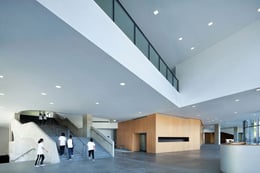Login
Registered users

Situated in the center of a new town just outside Beijing’s southwest fifth ring road, this new public school on 4.5 hectares of land is designed as the branch campus for the renowned Beijing No.4 High School. As an important piece in a grand scheme to build a healthier and self-sustainable new town, avoiding problems of the earlier mono-functional suburban developments, the school is vital to the development of the vast newly urbanized surrounding area.The intention of creating more open spaces filled with nature, something that urban Chinese students today desperately need, combined with the space limitations of the site, inspired a strategy on the vertical dimension to create multiple grounds, by separating the programs into above and below, and inserting gardens in-between. The juxtaposition of the resultant upper and lower building, connected at the ‘middle-ground’ in various ways, is as much an interesting spatial strategy as a signifier of the relationship between formal and informal educational spaces in the new school. The lower part contains large and non-repetitive public functions of the school, such as the canteen, the auditorium, the gymnasium, and the swimming pool. Each of these spaces with their varying height requirements, push the ground up from below into various mound shapes that touch the belly of the upper building; their roofs in the form of landscaped gardens become the undulating new open ‘ground’. The upper building is a thin rhizome shaped slab that contains the more repetitive and rigid programs of classrooms, labs, dormitories and administration. Its mega form extends, bends, and branches, but all connected together. The main circulation spine within this large structure is expanded to create special social areas, like a river with organic shaped islands that provide semi-private enclosures for small group activities. The roof-top of the upper building is designed to be an organic farm, with 36 plots for the 36-classes of students in the school, providing students the chance to learn the techniques of farming, and also paying tribute to the site’s pastoral past.
The tension between the two types of educational spaces and the rich mix of programs within create a surprising spatial complexity. With the unique identity designed for each different space, an urban experience is created within this complex of education facilities. Unlike a typical campus with hierarchical spatial organization and often clear axis to organize more or less symmetrical movements, the new school is free form and meant to have multiple centers that can be accessed in any possible sequences. It is a place with a free spirit that encourages explorations and awaits reinventions by different individuals. Hopefully the physical environment can inspire and initiate some much needed changes in the education system of China today. This project aims to be the first triple-green-star rated school in the country (a standard that exceeds LEED Gold). In order to maximize natural ventilation and natural light, and minimize heat gain during summer and heat loss in the winter, passive solar strategies are adopted in almost all aspects of the design, from the planning of the building geometry all the way to the details of the window design. Permeable ground surface paving and expansive green roofs helps to minimize surface run-off, and three large underground water retention basins collect precious rain water from the athletics field for irrigation of the farms and gardens. A geothermal ground-source heat pump provides a sustainable source of energy for the large public spaces, whilst independently controlled VRV units serve all the individual teaching spaces to ensure flexible operation. Throughout the project, simple, natural, and durable materials such as bamboo plywood, pebble dashing (a vanishing technique), stone, and exposed concrete are used. In the contemporary Chinese context, arguably the most pertinent issue and challenge is that of the relationship between the individual and society and between mankind and nature. Education bears great responsibilities. It is to these issues that this new campus project aspires to be both a touchstone and a response.









































Location: Changyang, Fangshan District, Beijing Client: Changyang Government of Fangshan District, Beijing
Completion: 2014
Gross Floor Area: 57,773 m²
Architects: Open Architecture
Principal Architecture: Li Hu, Huang Wenjing
Design Team: Daijiro Nakayama (project architect), Ye Qing / Zhang Hao (assistant project architect), Zhou Tingting, Thomas Batzenschlager, Zhang Chang, Jotte Seghers, Wang Yifan, Li Qiang, Ge Ruishi, Xue Wencan, Brendan Whitsitt, Ami Kito, Tao Wei, Simina Cuc, Zhao Yao, Chen Xiaoting, Cynthia Yurou Cui, Tang Wei, Liu Weijiang, Sheehan Watcher, Yu Qingbo, Felipe Escudero, Julia Mok, Lu Chen, Cheng Yanwei, Fan Jie, Scott Craven, Chris Gerdes, Beatrice Lau
General Contractor: Zhongxing Construction Co. Ltd.
Interior Contractor: Jiangsu Construction Engineering Group Co., Ltd. / Jin Longteng Decoration Co. Ltd.
Curtain Wall Contractor: Shenzhen Sanxin Curtain Wall engineering Co. Ltd.
Landscape Contractor: Beijing Changjian Yancheng Construction & Engineering Co. Ltd
Consultants
Local Design Institute: Beijing Institute of Architectural Design
Sustainability: School of Architecture, Tsinghua University
Structure: CABR Technology Co. Ltd.
Curtain Wall: Inhabit Group
Lighting: Lighting Design Partnership International (LDPi)
Acoustics: Clocell Signage
Design: Beijing Trycool Design
Photography: Su Shengliang, Xia Zhi